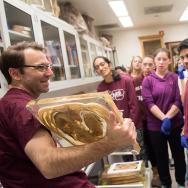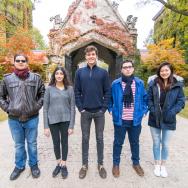Religious studies courses tend to focus on history-defining texts, forcing students to ask new questions about old works. This quarter at the University of Chicago is no different, featuring classes that interrogate foundational texts like the Quran, the New Testament and works from influential Buddhist philosophers.
But each year the Divinity School also invites UChicago graduate students to pitch ideas for innovative course ideas to teach undergraduates. For seventh-year doctoral candidate Russell Johnson, his ambitious interdisciplinary choice combined his field of study with one of the cultural icons of his youth.
“Star Wars and Religion” is a course that is both thoroughly in keeping with the school’s goals of understanding how humans come to find meaning in the world—and totally unlike anything the College has offered.
Since most students are casual Star Wars fans unfamiliar with religious scholarship, Johnson conceptualizes the course as an introduction to religious ethics and teaches it in an unconventional, accessible way.
“It’s very much an introductory-level course, using something familiar as a point of comparison to understand religious texts and traditions that are probably unfamiliar to a lot of the students taking the course. One of the goals is to show that the boundary between religion and science fiction is blurry and permeable,” Johnson said.
In a packed classroom in Swift Hall on a recent Thursday, Johnson and fellow doctoral candidate Mark Lambert—one of the course’s teaching assistants—treated students to a far-reaching lecture that seamlessly covered Saint Martin of Tours, sociologist Émile Durkheim and character Kylo Ren from The Force Awakens. One of the highlights was one of the lecture’s first slides—a depiction of the prototypical Madonna and child painting, but featuring C3PO and R2D2 from the Star Wars series in their place.
Over the course of the quarter, students will watch nine Star Wars films, from 1977’s Episode IV: A New Hope to last year’s The Last Jedi. They’ll supplement these screenings with readings from religious scholars, analyses of foundational religious texts and other works of science fiction similar to Star Wars.
Going on a ‘hero’s journey’
It might seem counterintuitive to put a seemingly secular film franchise in conversation with history’s most influential religious scholars and leaders. But as Johnson explained, Star Wars’ zealous fan base and religiously inspired storyline make the series hard to separate from broader questions of religion.
“When George Lucas first set out to write Star Wars, he said that he tried to distill the essence of the world’s religions and mythologies in creating the myth of the Star Wars universe, with the Jedi and the Force, and all of that,” Johnson said. “And in the process, he relied heavily on The Hero with a Thousand Faces, in which Joseph Campbell tries to lay out what he calls the ‘universal doctrine across religions and mythologies’ that takes the form of the ‘monomyth.’”
The basic structure of this monomyth—or the “hero’s journey”—involves a protagonist being called to adventure, descending into chaos, experiencing a revelation and transforming, and then ultimately emerging successfully with new wisdom to share. This prototypical journey unites seemingly disparate works—in films like The Dark Knight, Mean Girls and Guardians of the Galaxy, as Johnson explained—as well as many of the world’s foundational religious texts. Luke Skywalker’s journey might not be so different from Siddhartha Gautama’s, while Obi-Wan Kenobi’s might resemble “a prototypical saint story” too.
Students in Johnson’s class confront the monomyth firsthand in class presentations, connecting seminal steps on the hero’s journey to examples from ancient mythology and scenes from the Star Wars series. They also compare the Star Wars narrative to the structures of different religions, including Buddhism, Christianity, Judaism, Daoism and Zoroastrianism.
Changing nature of religion, Star Wars
Epitomizing the class’s eclectic approach, students will write an essay explaining the rules of the Force, its connection with the characters’ emotions and its relationship to other metaphysical forces across world religions.
“Discussions in the class have tied in the mythology of Star Wars with other religious stories in ways that I never would have considered on my own,” fourth-year Patrick Lou said. “Having no background in religious studies, I’m now intrigued by the field.”
Aside from having his students watch nine Star Wars films over ten weeks, Johnson is also encouraging them to note how religious elements are interpreted in new ways across the series. For example, the Jedi in the prequel series are more bureaucratic and highly structured, but this portrayal changes completely in the sequel trilogy.
“If you can understand how the different filmmakers interpret the more religious dimension of Star Wars, you can also understand the multifaceted and changing nature of a religious tradition. Just as Star Wars changes, religious traditions change what they focus on and what they highlight,” Johnson said.
As Johnson explained the many twists and turns his lectures will take, he jokingly clarified the one overarching constant of his course: “There is no normal.”
Perhaps that’s also a fitting anecdote for the transformative undergraduate education at UChicago, which asks students to think critically about ancient mythmakers and future universe traversers alike.

